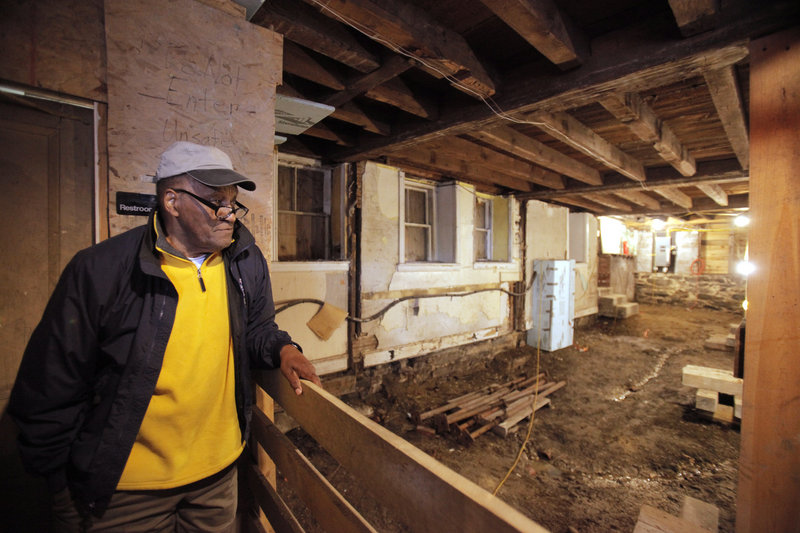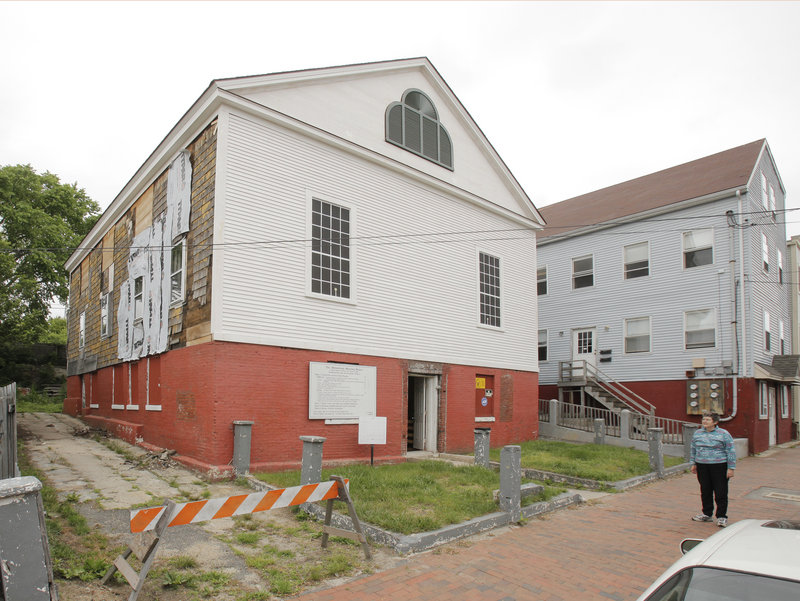PORTLAND – When George Cleeve and Richard Tucker first settled this city in 1632, they built their home next to a “runnet of water” at the foot of Munjoy Hill.
That runnet, which today is a tiny stream, now flows through the muddy basement of the Abyssinian Meeting House at 73-75 Newbury St.
This summer, the meetinghouse will begin a $100,000 project to fix the problem. The work will include an archaeological dig, followed by installation of a drainage system and concrete floor to make space for future programs.
It’s the latest step in a 15-years-and-running project to restore America’s third oldest black meetinghouse, which dates to 1832.
On a cold, rainy day this week, Leonard Cummings, chairman of the Committee to Restore the Abyssinian, gave a tour to four high school students and two Freedom Trail walkers.
Cummings, 76, pointed to the notches in the floor from the original 1830s pews, and a charred wall from a fire in the 1970s, as evidence of the building’s incredible history.
“In the Fire of 1866, everything around it burned down,” said Cummings, an African-American who wears his glasses low and speaks with a thick Maine accent. “Everything was destroyed except this. To this day, it still stands.
“One of the great untold stories in the city of Portland is this building right here.”
The Abyssinian’s restoration began in 1996 when his daughter, Deborah Cummings Kadraoui, learned about the building’s forgotten history as a vibrant center for African-American culture and life in the 19th century.
She started the restoration committee, and set out to transform the Abyssinian from a bedraggled and abandoned property to its original glory.
In 1998, the committee bought the Abyssinian from the city for $250, the same price that the founders paid for the land in 1827. The city had seized the building in the early 1990s due to delinquent taxes.
Over the last five-and-a-half years, the committee has raised about $600,000 and done countless improvements. Its goal: To restore the Abyssinian to what it looked like in 1870.
This winter, the committee finished a $125,000 project to begin restoring the building’s exterior.
Workers shored up the building’s structure and installed new clapboards using the same methods the founders did in the 1830s.
At the top of the exterior, a new Palladian window, a replica from the building’s 1870 facade, now looks out over Casco Bay.
“It’s great all the recognition we’ve gotten from so many organizations,” said David Paul, the committee’s treasurer. “But each one’s a new spyglass looking at us making sure we’re doing it right.
“If we don’t do it authentically, the building loses its historic value. So that adds to the cost.”
The committee never starts a project until all the funding is in place. The changes must also be approved in advance by numerous historical organizations, Paul said.
It has already raised funds for 90 percent of this summer’s project.
Over the years, the Abyssinian has received money from a variety of sources, including about $160,000 from the 1772 Foundation. Last year, it received $69,000 from the city’s Community Development Block Grant program, $43,346 from the Maine Historical Preservation Society and $25,000 from the Davis Family Foundation.
A former high school student, Cara Fontaine, once ran a bake sale and gave the Abyssinian her $100 profit.
Recently she sent another $100 from Florida, where she’s now attending college.
“I told her to bring some brochures to Florida with her,” Paul joked. “I like that story, though. It shows it’s a community project.”
The building exudes history. The floors are original, as well as the darker beams in the ceiling’s framework.
On the north wall, the silhouette of a cross was singed into the plaster during the 1970s fire, forever marking it as a religious institution.
Ultimately, the committee hopes to turn the Abyssinian into an “active museum” with community programs, plays and exhibits. The latest touch includes an array of portraits of the famous preachers, historical characters and freed slaves who came through the Abyssinian or called it home.
The meetinghouse is the only official Underground Railroad site in Maine, according to the U.S. Department of the Interior.
The committee is displaying artifacts of that history, including a copy of the Portland Union Anti-Slavery Society’s constitution, which was drafted at the meetinghouse in 1842.
Once the cruise ships start arriving in July, the committee hopes — for the first-time ever — to have a full-time staff member to give tours to visitors, Cummings said. Currently, interested parties must contact the committee in advance to arrange a showing.
“It’s been a building that’s been obscured for many years,” Cummings said. “So we want to make the people of Portland aware that it’s here and that it has huge history. It’s the history of African-Americans, of the Civil War, of Maine and of the people of Maine.”
Staff Writer Jason Singer can be contacted at 791-6437 or:
jsinger@mainetoday.com
Send questions/comments to the editors.




Success. Please wait for the page to reload. If the page does not reload within 5 seconds, please refresh the page.
Enter your email and password to access comments.
Hi, to comment on stories you must . This profile is in addition to your subscription and website login.
Already have a commenting profile? .
Invalid username/password.
Please check your email to confirm and complete your registration.
Only subscribers are eligible to post comments. Please subscribe or login first for digital access. Here’s why.
Use the form below to reset your password. When you've submitted your account email, we will send an email with a reset code.